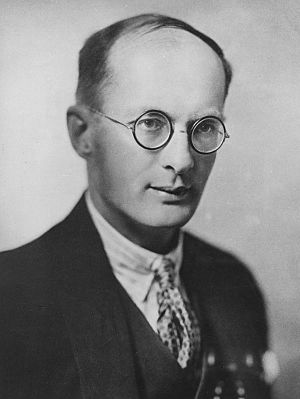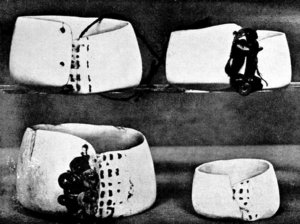Bronisław Malinowski facts for kids
Quick facts for kids
Bronisław Malinowski
|
|
|---|---|

Bronisław Malinowski
|
|
| Born |
Bronisław Kasper Malinowski
7 April 1884 |
| Died | 16 May 1942 (aged 58) New Haven, Connecticut, U.S.
|
| Nationality | Polish |
| Citizenship | Austro-Hungarian, Polish, British |
| Alma mater | Jagiellonian University (PhD, 1908) London School of Economics (D.Sc., 1916) |
| Known for | Father of social anthropology, popularizing fieldwork, participatory observation, ethnography and psychological functionalism |
| Spouse(s) | Elsie Rosaline Masson, Valetta Swann |
| Children | 3 |
| Parent(s) |
|
| Scientific career | |
| Institutions | London School of Economics, Yale University |
| Thesis | On the Principle of the Economy of Thought (1908) |
| Doctoral students |
|
| Other notable students |
Jomo Kenyatta
Raymond Firth E. E. Evans-Pritchard Z. K. Matthews H. Powdermaker Meyer Fortes Fei Xiaotong |
| Influences | James Frazer William James Émile Durkheim Charles Gabriel Seligman Edvard Westermarck Wilhelm Wundt |
| Influenced | Virtually all subsequent social anthropology |
Bronisław Kasper Malinowski (born April 7, 1884 – died May 16, 1942) was a very important Polish-British anthropologist. An anthropologist is someone who studies human societies and cultures. Malinowski's ideas about how to study people, especially through field research, changed the way anthropology was done forever.
He was born in a part of Poland that was then controlled by Austria-Hungary. He studied at Jagiellonian University in his hometown of Kraków. Later, he moved to England and studied at the London School of Economics (LSE).
In 1914, he traveled to Australia and then to the Trobriand Islands in New Guinea. He spent several years there, living with and studying the local people. This was a new way of doing research.
After World War I, he returned to England. He published his famous book, Argonauts of the Western Pacific (1922). This book made him one of the most important anthropologists in Europe. He taught at the LSE and influenced many students. Later in his life, he taught at Yale University in the United States. He died in 1942.
Malinowski's studies of the Trobriand Islands helped explain the Kula ring. This was a complex system of trading valuable items. His work also made participatory observation popular. This is when a researcher lives among the people they study to understand their daily lives. He believed that cultural practices help people meet their basic human needs.
Contents
Who Was Bronisław Malinowski?
His Early Life and Studies
Bronisław Malinowski was born on April 7, 1884, in Kraków, Poland. At that time, Poland was divided, and Kraków was part of the Austro-Hungarian Empire. His father, Lucjan Malinowski, was a university professor.
As a child, Bronisław was often sick, but he was very good at school. He went to Jagiellonian University in Kraków. He first studied math and science. While recovering from an illness, he became interested in social sciences, which study human society. In 1908, he earned his PhD in philosophy.
He enjoyed traveling and visited many countries. After reading a book called The Golden Bough by James Frazer, he decided to become an anthropologist. In 1910, he moved to England to continue his studies at the London School of Economics.
Exploring New Cultures
In 1913, Malinowski published his first book in English. It was called The Family among the Australian Aborigines. In June 1914, he left London for an expedition to Papua New Guinea.
When World War I started, Malinowski was a citizen of Austria-Hungary, which was at war with Britain. This made his situation difficult. However, with help from his friends, British authorities allowed him to stay and continue his research.
His first trip was to Toulon Island and Woodlark Island. He then spent a lot of time in the Trobriand Islands in Melanesia. He made two long trips there, from 1915 to 1916 and from 1917 to 1918. During this time, he studied the Kula ring and developed his famous method of participant observation. This means he lived right in the villages he studied. He learned their language and took part in their daily lives. This helped him understand their culture deeply.
After the war, he returned to Europe in 1919. He started teaching again at the London School of Economics in 1921. The next year, his most famous book, Argonauts of the Western Pacific, was published. For the next 20 years, he made the LSE a leading center for anthropology. He became a full professor in 1927.
In 1934, he traveled to Africa to study tribes like the Bemba and Kikuyu. When World War II began, he was visiting the United States and stayed there. He taught at Yale University until he died. He also spoke out against Nazi Germany.
Bronisław Malinowski died on May 16, 1942, at age 58. He had a stroke while preparing for more fieldwork.
His Important Books and Ideas
Most of Malinowski's research was published in English. His first book, The Family among the Australian Aborigines (1913), was praised for showing that Aboriginal Australians did have family structures.
His book Argonauts of the Western Pacific (1922) was about the Trobriand people. It was seen as a masterpiece and greatly increased his fame. Other important books included Crime and Custom in Savage Society (1926) and Coral Gardens and Their Magic (1935).
After he died, some of his personal writings were published. One was A Diary in the Strict Sense of the Term (1967). This diary, written in Polish, caused some discussion. It showed his personal thoughts during his fieldwork. Some scholars found it surprising, but others later called it an important look into the life of an anthropologist.
Living Among the People: Fieldwork
Malinowski is known as one of the best ethnographers in anthropology. An ethnographer studies and describes human cultures. He is famous for taking anthropology "off the verandah". This means he believed researchers should not just observe from a distance. Instead, they should live with the people they study.
He would set up his tent right in the middle of the villages. He lived there for weeks or months at a time. This allowed him to have daily contact with the people. He could observe the "imponderabilia of everyday life"—the small, important details that make up a culture. His goal was to understand the world from the native people's point of view. This method, called participant observation, is still a key part of anthropological research today.

Malinowski often criticized earlier anthropologists. Many of them wrote books based on stories from others, not from their own direct experience. He believed that living with the people was the only way to get accurate information.
Understanding Culture: Functionalism
Malinowski helped create a school of thought called functionalism in anthropology. He believed that every part of a culture, like its customs or traditions, serves a purpose. These purposes help meet the basic needs of individuals. For example, a food supply meets the need for metabolism. Kinship systems meet the need for reproduction. Shelter meets the need for bodily comfort.
He argued that if the needs of individuals are met, then the needs of the whole society are also met. He showed how cultures work together to help people survive and thrive.
His research on the Kula ring is a great example. This was a complex trading system in the Trobriand Islands. It showed how economics was deeply connected to the culture and not just about money. He also showed that what some called "primitive superstition" was actually a complex mix of magic, science, and religion.
Malinowski also influenced African studies. Many of his students went on to do important research in Africa. He even wrote the introduction to a book by Jomo Kenyatta, who later became the first president of Kenya.
A Great Teacher
Malinowski taught many future anthropologists, especially in Britain. His teaching style was very exciting. He was known for being friendly and fair to all his students, including women.
Some of his famous students included Raymond Firth, Meyer Fortes, Jomo Kenyatta, Edmund Leach, and Audrey Richards. They all went on to become important social scientists.
How He Is Remembered

There is an annual lecture series at the London School of Economics named after him, called the Malinowski Memorial Lecture. A student magazine there is also named The Argonaut, after his famous book.
The Society for Applied Anthropology gives out the Bronislaw Malinowski Award in his honor. This award recognizes people who have used anthropology to solve real-world problems.
His life and work have also been featured in books and a documentary film by BBC Four in 2007.
His Family Life
In 1919, Malinowski married Elsie Rosaline Masson, an Australian writer and photographer. They had three daughters: Józefa, Wanda, and Helena. Elsie passed away in 1935. In 1940, Malinowski married Valetta Swann, an English painter. His daughter Helena later wrote a book about her parents.
Although he was raised Roman Catholic, Malinowski later described himself as agnostic. This means he believed it was not possible to know if God exists.
Error: no page names specified (help). In Spanish: Bronisław Malinowski para niños
In Spanish: Bronisław Malinowski para niños



